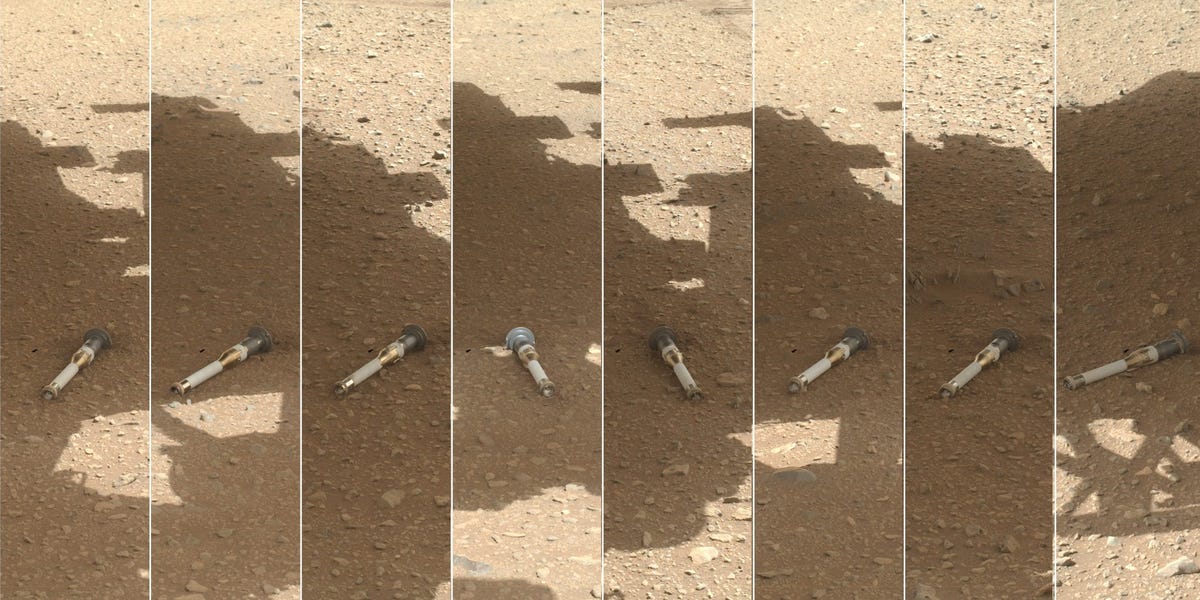A rock core is visible inside the sample tube of the Perseverance rover.
NASA’s Perseverance Mars rover is in the process of gathering samples that could potentially serve as evidence of ancient extraterrestrial life. However, the project is now projected to cost $11 billion and span over two decades. Consequently, NASA has decided to abandon the original plan and is seeking alternative proposals from various companies.
When the rover was sent to collect samples, NASA may have overestimated its capabilities. The mission, costing $2.4 billion, is situated at the site of an ancient lake, making it an ideal location to search for possible fossils of microbial life that might have thrived when Mars was abundant with lakes and rivers.
The primary objective of Perseverance is to analyze the rock and sediment layers within the lake bed and the crater rim, aiming to discover indications of past life on the Martian surface. While the rover has successfully secured 24 samples thus far, NASA is currently facing uncertainties regarding the transportation of these samples back to Earth for further examination.
The remnants of an ancient river delta at the periphery of Jezero Crater were captured by the ESA’s Mars Express orbiter. The peculiar-looking objects on the Martian surface are not lightsabers but rather sample tubes belonging to the Perseverance rover.
The initial plan devised by NASA for the retrieval mission, known as Mars Sample Return, has encountered setbacks. Consequently, the agency is reassessing its approach and soliciting improved concepts from various entities.
The original proposal for the Mars Sample Return project was deemed excessively intricate by David Parker, the director of space exploration at the European Space Agency. The elaborate plan involved launching two rockets towards Mars, with one carrying a lander and the other an orbiter. The lander, upon touchdown near Perseverance’s sample stash, would deploy a rover to retrieve the sample tubes and load them onto a small rocket attached to the lander.
Subsequently, the rocket would propel the samples into Mars orbit, from where they would be directed towards the orbiter, the largest spacecraft ever dispatched by NASA to Mars. The orbiter would then capture the samples, maneuver them into its cargo hold, and release the sample container on a trajectory towards Earth for retrieval.
Originally estimated to require about \(4 billion in new technology and a decade of meticulous planning and construction, the Mars Sample Return mission’s projected cost has escalated to \)8 to $11 billion post-Perseverance’s landing. Independent assessments have also indicated that the timeline for returning the samples to Earth has doubled from one decade to two.
Acknowledging the exorbitant costs and prolonged timeline, NASA Administrator Bill Nelson expressed the urgency to devise a more cost-effective and time-efficient strategy. The current budget for the Mars Sample Return mission is deemed unsustainable and would impede other NASA missions, prompting the agency to collaborate internally and externally to formulate a more viable plan.
To expedite the process, NASA has called for brief proposals from companies or laboratories by May 17, with selected competitors given 90 days to refine their concepts before submitting comprehensive proposals to NASA by late fall or early winter. Notable contenders include Lockheed Martin, Northrop Grumman, Boeing, and SpaceX, along with emerging companies like Astrobotic and Intuitive Machines participating in NASA’s lunar initiatives.
NASA aims to revert to conventional and proven technologies for the project, emphasizing the importance of practical and reliable solutions over groundbreaking technological advancements. However, the return journey from Mars will inherently involve pioneering technological feats, considering the unprecedented challenge of launching from another planet.
The complexity of the Mars Sample Return mission lies in the fact that it necessitates a launch from Mars, a milestone that has never been achieved before in space exploration. Despite the inherent challenges, NASA remains optimistic about the mission’s success and the valuable insights it could provide.
